
MoU : S-VYASA and BNMIT
June 2, 2021
Students, parents anxious over class 12th results and admission to professional UG courses
June 9, 2021Butterflies, snails, spiders, dragon flies, damsel flies, grasshoppers, millipeds, praying mantis! The list of their favorite insect is endless. On World Environment Day today (June 5), we talk to BNMIT ‘insect’ engineers, students on campus who document different species of these wonderful creatures that we share our planet with.
True, insects can sting! Also true, they can startle us! However, they form a very vital cog in the ecological machine. Often overlooked as tiny and trifling, bugs are scientific community’s best friends when it comes to accessing the health of the environment. These buzzing, crawling, and hovering midgets play an important role in our ecosystem and while most of us ignore them, there are some, who understand what the world would lose if insect population plummets. They believe that while insects lack the charisma of a polar bear or a Bengal tiger, their importance in maintaining a healthy ecosystem in uncontestable.
Vaidehi Maiya, Second Year, Mechanical Engineering
Meet Vaidehi Maiya, the 21-year-old mechanical engineering student at BNMIT documents butterflies. She fell in love with this winged insect while she was in class VII.
‘They are not just beautiful but are a complex creature too. Their metamorphosis from caterpillar in chrysalis to a full-grown butterfly has always fascinated me. When I spot a butterfly, I do not want it to get out of my sight’, says Vaidehi, who has clicked and identified over 20 butterfly species so far.
Mesmerized with the role that the butterflies play in nature, Vaidehi wants to use the images she has clicked and information she has gathered, in spreading awareness. ‘Butterflies and moths are effective pollinators and act as natural pest controls too. They form an important part of the food chain, providing food for birds, bats, and other animals, they act as decomposers and a good indicators of habitat loss and climate change. It is wonderful to watch them in complete harmony with nature and sticking by the rules. I want to keep documenting them and use this information to spread awareness’, says Vaidehi.



Short banded sailor (left) and blue mormon (right) clicked by Vaidehi
Vighnesh Nandavar, Final Year, Mechanical Engineering

According to Vighnesh Nandavar, one needs to go beyond the books and observe insects in their natural habitat to grasp their role in maintaining a healthy ecosystem.
“There are wonderful secrets hidden in the insect world. Observing their behaviour and strategy in their natural environment opens up the door to their intriguing life. It is watching them in action that paints the real picture of how an ecosystem works in unison,” says Vignesh.
Vignesh observes and documents butterflies and spiders. It all began for him on a college trip to Big Barn farm in 2018. “The five-day trip introduced me to the beautiful world of birds and insects. I got interested in birding and slowly started documenting birds. On yet another similar trip, I witnessed earth movers in action and after that there has been no looking back,” says Vighnesh, who joined a team of an IISc researchers during a semester break to document spiders this time, unaware of what was in store for him.
“I have feared spiders since my childhood. Their long legs, dark colour, and slow movement have always spooked me. However, I was supposed to document them now and had to brave my fear,” recalls Vignesh.
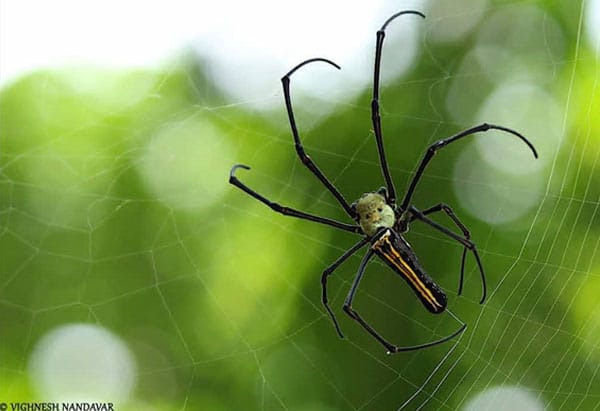
A wood spider caught in action by Vighnesh
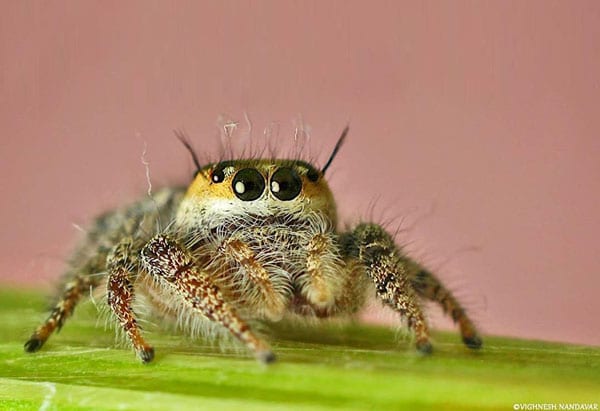
A female jumping spider captured by Vighnesh
It was during the one-month long internship that Vignesh fell in love with the insect that he once feared the most. “One of the criteria of documentation of the spiders is to photograph their eye pattern. Jumping spider has a different eye pattern than a link spider. This got me into macrophotography, and I started clicking spiders’ eyes. I had no idea that spiders have the most beautiful eye patterns,” says a mesmerized Vignesh, who has documented around 20 species of spiders on BNMIT campus. Giant wood spider, eriovixia, spitting spider, green lynx, garden orb weaver, crab spider and two-tailed spider are only some of the species documented by Vignesh, who also likes observing and documenting grasshoppers, millipeds, dragon flies, damsel flies, and butterflies.
“Spiders are one of the most important predators in many ecosystems. They form a great garden allies by feeding on a variety of pests, thus controlling various diseases in plants,” informs Vighnesh.
Omkar N Kashyap, Final Year, Mechanical Engineering
The flight of insects has fascinated physicists and biologists for more than a century, and the engineers-in-making on BNMIT campus are no different. It was a damselflies’ hovering and maneuvering skill that caught Omkar N Kashyap’s attention.
“I was passionate about flying insects since a very young age. It is fascinating how they hover and change their direction in a fraction of second. This got me interested in their wing pattern and I started looking into the aerodynamics of these insects. It is the corrugations in its wings that helps in trapping air, recirculates it and use this feature to maneuver and change the direction quickly,” says Omkar.
The damselflies’ wing pattern and flight inspired the 21-year-old so much so that Omkar ended up writing a paper on it. Titled ‘Study of flow around bio-inspired corrugated aero-foils in low Reynolds number regime’, the paper been accepted by the American Institute of Physics for publication.

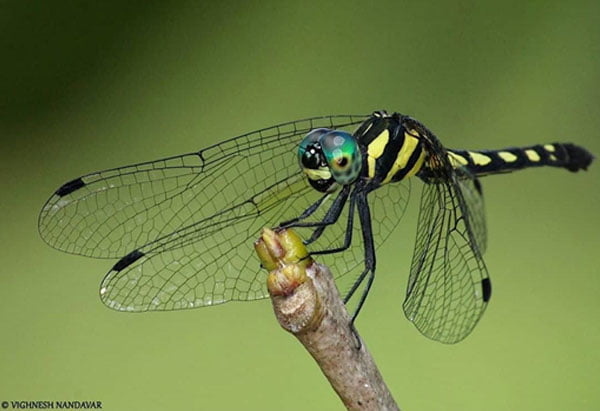
Pigmy dragonfly captured by Omkar
However, it is not just the ‘wing science’ that keeps Omkar hooked to this beautiful insect.
“This insect family is an amazing natural pest controller. While damsel beetles can help plants infected by aphids, dragon flies can free plants infected with mealybugs. The more we use the natural pest controllers, the less fertilizer is required. To add to this, these flies also feed on mosquito larvae and can be an excellent indicator of water quality. If you spot damselflies hovering over a water body, there is a high chance that it is a mosquito breeding ground,” says Omkar.
Sumukh A Shenoy, Second Year, Mechanical Engineering

Away from beautiful wings and the science of corrugations, the insect of interest for this BNMITian is snails. According to Sumukh, watching a snail move inspires him.
“I got introduced to nature and the world of insects on one of our college trips. It had rained and I found a guy (snail) crawling near my feet. I remember marking a point few inches away from the snail, and while it took few minutes to reach the mark, it never gave up. It kept moving continuously,” recalls Sumukh, who also understand the importance that these slow-moving insects in ecosystem functioning.
“Snails eat very low on the food web. The mostly consume rotting vegetation like moist leaf litter, and fungi and sometimes eat soil directly. This helps in decomposition. Moreover, since they are carnivorous, they help keep other species in check too,” adds Sumukh, who also documents praying mantis and butterflies.
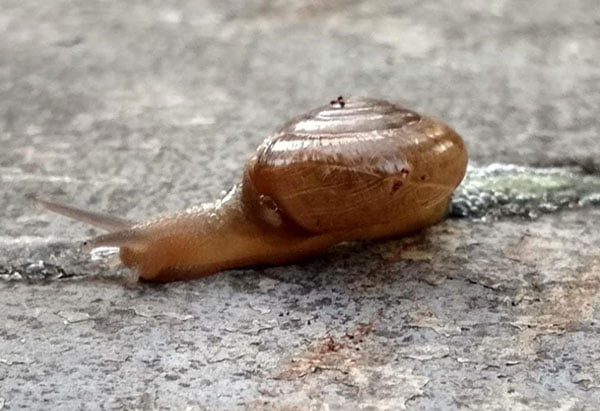
Land snail captured by Sumukh
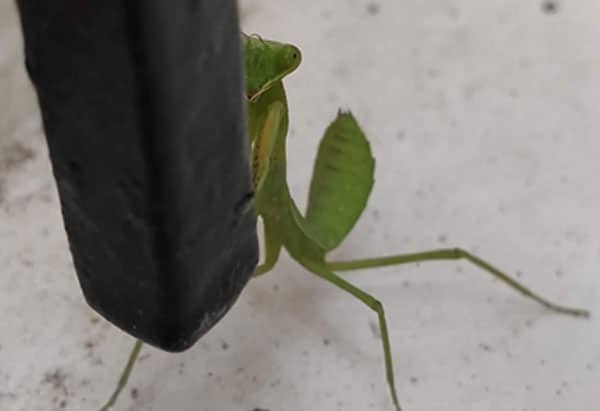
A praying mantis on BNMIT campus that captured Sumnukh’s attention
All the four students are part of BNM Friends of Nature Club. The club is led by BNMIT founder secretary Sri Narayan Rao R Maanay and has about 450 student members. The club provides a platform for the students to participate in its Nature awareness through various on campus and off campus activities, including field trips.

